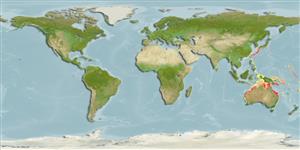>
Callionymiformes (Dragonets) >
Callionymidae (Dragonets)
Etymology: Callionymus: Greek, kallion, comparative of kallos = beautiful + Greek, onyma = name; with a better name .
More on author: Ogilby.
Environment: milieu / climate zone / depth range / distribution range
Ecología
marino; salobre demersal. Tropical
Western Pacific: northern Australia.
Tamaño / Peso / Age
Maturity: Lm ? range ? - ? cm
Max length : 25.0 cm TL macho / no sexado; (Ref. 7292)
Espinas dorsales (total) : 4; Radios blandos dorsales (total) : 9; Radios blandos anales: 9. Lateral line distinct, first dorsal fin distinctly colored (Ref. 9002). Body brown above, closely speckled with darker spots of varying sizes, whitish below. First dorsal fin with a black spot on third spine. Filamentous spines with numerous grey annuli. Second dorsal fin, caudal fin, pectoral and pelvic fins with darker spots. Anal fin with a broad dusky margin. Occipital region without bony ridges or protuberances, but with numerous small granular rugosities. Males with a black spot on third spine of first dorsal fin (Ref 42832).
Found on coastal and sandy estuaries along seagrass and reef margins, usually in small aggregations (Ref. 9002).
Life cycle and mating behavior
Maturities | Reproducción | Spawnings | Egg(s) | Fecundities | Larva
Grant, E.M., 1986. Guide to fishes. Reprinted edition. The Department of Harbours and Marine. Brisbane, Queensland. 896 p. (Ref. 7292)
IUCN Red List Status (Ref. 130435)
Threat to humans
Harmless
Human uses
Herramientas
Special reports
Download XML
Fuentes de Internet
Estimates based on models
Preferred temperature (Ref.
123201): 23.3 - 28.6, mean 27.4 °C (based on 326 cells).
Phylogenetic diversity index (Ref.
82804): PD
50 = 0.5000 [Uniqueness, from 0.5 = low to 2.0 = high].
Bayesian length-weight: a=0.00912 (0.00408 - 0.02036), b=2.77 (2.59 - 2.95), in cm total length, based on LWR estimates for this Genus-body shape (Ref.
93245).
Nivel trófico (Ref.
69278): 3.3 ±0.4 se; based on size and trophs of closest relatives
Resiliencia (Ref.
120179): Medio, población duplicada en un tiempo mínimo de 1.4-4.4 años (Preliminary K or Fecundity.).
Fishing Vulnerability (Ref.
59153): Low vulnerability (15 of 100).
